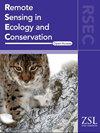利用哨兵-1 图像推进绘制热带草原植被结构图的工作
IF 4.3
2区 环境科学与生态学
Q1 ECOLOGY
引用次数: 0
摘要
植被结构监测对认识和保护热带稀树草原生态系统具有重要意义。光学卫星图像可用于估算树冠覆盖度,但提供的关于稀树草原结构的信息有限,而且仅限于白天和晴空的捕获。主动遥感可以潜在地克服这一点。我们探索了C波段合成孔径雷达成像在稀树草原草地和木本植被结构制图中的应用。我们校准了Sentinel‐1 VH()和VV()后向散射系数及其与基于地面估算的大塞伦盖蒂-马拉生态系统中草生物量、木质冠层体积(<;5万m3/ha)和树木基面积(<15 m2/ha)的比值,并同时探索了它们对土壤湿度的敏感性。我们发现,特别是可以用来估算旱季的草生物量(R2 = 0.54, RMSE = 630 kg/ha, %范围= 20.6),木质冠层体积(R2 = 0.69, RMSE = 4188 m3/ha, %范围= 11.8)和树木基面积(R2 = 0.44, RMSE = 2.03 m2/ha, %范围= 18.6),允许外推到区域尺度的植被结构图。我们还引入了土壤湿度的新代用物,作为将该方法扩展到雨季的一种选择,使用气候危害组红外站降水(CHIRPS)和全球降水测量多卫星检索(IMERG)数据集的90天前有边界运行平均值。我们讨论了Sentinel - 1图像在更好地理解热带稀树草原植被结构时空动态方面的潜力。本文章由计算机程序翻译,如有差异,请以英文原文为准。
Advancing the mapping of vegetation structure in savannas using Sentinel‐1 imagery
Vegetation structure monitoring is important for the understanding and conservation of savanna ecosystems. Optical satellite imagery can be used to estimate canopy cover, but provides limited information about the structure of savannas, and is restricted to daytime and clear‐sky captures. Active remote sensing can potentially overcome this. We explore the utility of C‐band synthetic aperture radar imagery for mapping both grassland and woody vegetation structure in savannas. We calibrated Sentinel‐1 VH () and VV () backscatter coefficients and their ratio () to ground‐based estimates of grass biomass, woody canopy volume (<50 000 m3 /ha) and tree basal area (<15 m2 /ha) in the Greater Serengeti‐Mara Ecosystem, and simultaneously explored their sensitivity to soil moisture. We show that in particular can be used to estimate grass biomass (R 2 = 0.54, RMSE = 630 kg/ha, %range = 20.6), woody canopy volume (R 2 = 0.69, RMSE = 4188 m3 /ha, %range = 11.8) and tree basal area (R 2 = 0.44, RMSE = 2.03 m2 /ha, %range = 18.6) in the dry season, allowing for the extrapolation to regional scale vegetation structure maps. We also introduce new proxies for soil moisture as an option for extending this approach to the wet season using the 90‐day preceding bounded running averages of the Climate Hazards Group InfraRed Precipitation with Station (CHIRPS) and the Multi‐satellitE Retrievals for Global Precipitation Measurement (IMERG) datasets. We discuss the potential of Sentinel‐1 imagery for better understanding of the spatio‐temporal dynamics of vegetation structure in savannas.
求助全文
通过发布文献求助,成功后即可免费获取论文全文。
去求助
来源期刊

Remote Sensing in Ecology and Conservation
Earth and Planetary Sciences-Computers in Earth Sciences
CiteScore
9.80
自引率
5.50%
发文量
69
审稿时长
18 weeks
期刊介绍:
emote Sensing in Ecology and Conservation provides a forum for rapid, peer-reviewed publication of novel, multidisciplinary research at the interface between remote sensing science and ecology and conservation. The journal prioritizes findings that advance the scientific basis of ecology and conservation, promoting the development of remote-sensing based methods relevant to the management of land use and biological systems at all levels, from populations and species to ecosystems and biomes. The journal defines remote sensing in its broadest sense, including data acquisition by hand-held and fixed ground-based sensors, such as camera traps and acoustic recorders, and sensors on airplanes and satellites. The intended journal’s audience includes ecologists, conservation scientists, policy makers, managers of terrestrial and aquatic systems, remote sensing scientists, and students.
Remote Sensing in Ecology and Conservation is a fully open access journal from Wiley and the Zoological Society of London. Remote sensing has enormous potential as to provide information on the state of, and pressures on, biological diversity and ecosystem services, at multiple spatial and temporal scales. This new publication provides a forum for multidisciplinary research in remote sensing science, ecological research and conservation science.
 求助内容:
求助内容: 应助结果提醒方式:
应助结果提醒方式:


